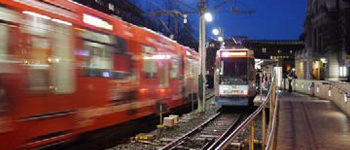

Client: City of Bielefeld
End: 2012
The City of Bielefeld and the local LRT and bus operator (moBiel GmbH) developed an LRT network extension vision for the 330,000 inhabitants called „Light Rail 2030“. This vision includes 15 potential extension corridors.
TTK studied the demand potential of each corridor. A GIS-model for the whole city was developed to support the evaluation of passenger potential.
The goals of the study are to estimate passenger potential, the economic benefits and to prioritise the corridors against each other. The results should enable city representatives to decide which corridors should be considered for more detailed studies.
In addition a detailed feasibility study for the LRT corridor to Heepen including design plans at 1:1,000 scale and plans for urban integration are part of the overall project.
As an initial step the study also has to provide resilient basic data for future technological decisions. At present the network is a high floor system with meter gauge and a vehicle width of 2.30m. However, the first new high floor Vamos vehicles with a width of 2.65m are already delivered and the required track adaptations for the Vamos are currently in progress.
For future extensions the technical and economic impacts of track gauge adaptations, lowfloor vehicles and a standard vehicle width of 2.65 m were assessed.
The overall assignment is separated into three phases:

Network development study including a detailed feasibility analysis for the corridor to Heepen